What Does First-Party Claims Mean in the Legal Space?
In the legal realm, especially in the context of insurance, the term “first-party claims” refers to claims made by an individual or business to their own insurance provider for compensation or coverage of losses they have directly suffered. Understanding first-party claims is crucial, as they are a key component of many insurance agreements, ensuring that policyholders receive benefits for damages or injuries covered under their policies. The Munley Law Glossary provides a comprehensive definition of first-party claims, which are foundational in various types of insurance policies such as auto, homeowners, and health insurance.
Defining First-Party Claims
A first-party claim occurs when the insured (the policyholder) files a claim with their own insurance company after experiencing a loss or damage covered by their insurance policy. In essence, the claim is made against the insurance company that provided coverage to the policyholder, rather than against another party. This is distinct from third-party claims, where a claim is made against another individual’s or business’s insurance for damages caused by that third party.
For example, if a person has auto insurance and their vehicle is damaged in an accident, they would file a first-party claim with their insurance company to cover the costs of repairs. If the policy includes coverage for personal injury protection (PIP), the individual can also file a first-party claim for medical expenses and lost wages due to injuries sustained in the accident.
Types of First-Party Claims
First-party claims can be found in various types of insurance policies, including but not limited to:
Auto Insurance Claims: This includes claims made for property damage to one’s own vehicle, as well as claims for personal injury protection (PIP) and medical payments coverage. For instance, if your car is damaged in a collision, or if you suffer injuries in an accident, you can file a first-party claim with your auto insurance provider for compensation.
Homeowners Insurance Claims: First-party claims under homeowners insurance are typically made for property damage or loss due to events such as fire, theft, or natural disasters. If your home sustains damage from a covered peril, like a storm or fire, you can file a claim with your homeowners insurance company to cover repair or replacement costs.
Health Insurance Claims: First-party claims in health insurance occur when a policyholder seeks reimbursement for medical expenses covered under their health insurance plan. This can include claims for hospital visits, surgeries, or prescription medications.
Disability Insurance Claims: A policyholder with disability insurance can file a first-party claim to receive benefits if they are unable to work due to illness or injury. These claims provide financial compensation to help cover lost wages during the period of disability.
The Process of Filing a First-Party Claim
When a policyholder experiences a loss or injury, they must follow specific steps to file a first-party claim. While the process may vary slightly depending on the type of insurance and the company, the general steps include:
Notifying the Insurance Company: The policyholder should contact their insurance company as soon as possible after the loss or injury occurs. Many policies require timely notification, and delaying too long may result in the denial of a claim.
Providing Documentation: The policyholder must provide documentation to support the claim. This may include receipts, estimates for repairs, medical bills, police reports (in the case of an accident), or photographs of the damage.
Assessment by the Insurance Company: Once the claim is filed, the insurance company will assess it by reviewing the policyholder’s coverage, examining the evidence, and potentially sending an adjuster to inspect the damage. For example, in homeowners insurance claims, an adjuster may visit the property to assess the extent of the damage.
Settlement: If the claim is approved, the insurance company will offer a settlement, which may be a lump sum or periodic payments, depending on the type of claim. The settlement amount will reflect the coverage limits specified in the policy.
Challenges in First-Party Claims
While first-party claims are meant to provide protection and compensation for covered losses, the process isn’t always straightforward. Policyholders may face several challenges, including:
Claim Denials: Insurance companies may deny first-party claims if they believe the damage or injury is not covered under the policy. For instance, if an insurance company determines that the damage to a home was caused by wear and tear rather than a covered peril like a fire or storm, they may deny the claim.
Underpayment: Even if a claim is approved, some insurance companies may offer less compensation than the policyholder believes is justified. In these cases, the policyholder may need to negotiate with the insurance company or seek legal help to receive fair compensation.
Delays in Processing: Insurance companies are required to handle claims in a timely manner, but some may delay the process, leaving policyholders waiting for the funds they need to cover repairs, medical bills, or lost wages.
Continue Reading →
